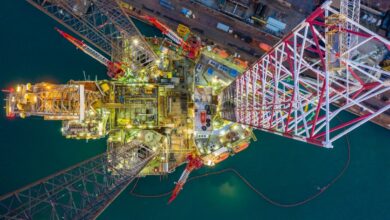Liam Mallon, ExxonMobil: Lower-for-longer environment has transformed industry’s mindset on innovation, collaboration
By Kelli Ainsworth Robinson, Associate Editor

The lower-for-longer price environment has forced oil and gas companies to change their mindsets, resulting in innovation, collaboration and standardization that have cut cycle times in half. The result is that new frontier projects, like ExxonMobil’s Liza development offshore Guyana, have become economic once again. While no one knows when, if ever, oil prices will return to pre-downturn levels, what’s certain is that the industry cannot afford to revert to old ways of doing business even if prices do improve in the future, Liam Mallon, President of ExxonMobil Development Co, said in a keynote session on 6 March at the 2018 IADC/SPE Drilling Conference in Fort Worth, Texas.
“Shame on us if we lose the discipline, mindset and the innovation that (the downturn) has driven,” he said. “We have lost that discipline every time we’ve had a cycle. We come out of it, and everyone thinks we’re done, then we get inefficient and bloated. We cannot afford to do that again.”
So far, the results from the industry’s efficiency improvement efforts have been stellar. Onshore US, for example, the rig count has risen by 30% over the past year. There has also been a threefold increase in non-US FIDs between 2016 and 2017. Costs, so far, are being kept in check despite these increases in activity. “We have not seen a threefold increase in spend,” he said. “The discipline around capital is like we’ve never seen before. It means the industry is able to make those projects work in this lower-for-longer framework.”
To keep the industry on this track going forward, Mr Mallon urged companies to remain focused on three themes, no matter how the price environment changes: innovation, excellence in execution, and collaboration.
In terms of innovation, Mr Mallon noted that tremendous strides have already been made in terms of automating drilling rigs and the drilling process. For instance, ExxonMobil plans to drill slip to slip with full automation in Guyana and Eastern Canada by the end of this year. However, more can be done. In fact, he said, the use of advanced data analytics and artificial intelligence (AI) remains “virtually untapped.”
“The use of artificial intelligence, the use of advanced data analytics and the use of significant automation to take people out of harm’s way is in its infancy,” he said, urging the industry to continue improving sensor interfaces.
E&P companies must also continue to focus on excellence in execution, a big part of which is safety. Still too often, Mr Mallon said, there is still a belief that a company can’t be both efficient and profitable at the same time. “We can, and we must do better. It really takes all of us embracing this concept that good safety is good business,” he said.
Finally, collaboration has been instrumental in driving down cycle times and costs in the upstream industry, Mr Mallon said. He pointed to the joint IADC and the International Association of Oil and gas Producers RAPID-S53 database, which collects and analyzes data on BOP failures, as an example of industry collaboration that has resulted in major performance and safety improvements.
Collaboration through other industry workgroups has also helped reverse the trend of increasing specifications and driven down delivery times for equipment like subsea wellheads and trees. Efforts to standardize requirements for this equipment has cut their delivery times by more than half, Mr Mallon said. Now, instead of waiting up to three years for the delivery of a subsea tree, as operators did four years ago, they now only have to wait less than a year. “I will tell you a significant piece to making it work in a lower-for-longer environment was getting those cycle times down,” he added. However, there is more work to be done. There are hundreds of additional equipment classes that could be standardized, which would drive cycle times even further down.
The industry has a moral imperative to continue to innovate and collaborate in order to satisfy the world’s energy demand, regardless of oil price, Mr Mallon said. As it stands, by 2040, demand for oil and gas will require the E&P industry to produce an additional 61 million bpd on top of the estimated 97 million bpd that’s already produced. Meeting this demand is necessary to lift over a billion people around the world out of poverty, Mr Mallon said. He noted that one billion people around the world do not have electricity, and two billion do not have access to electric or gas stoves for cooking. “The reason we’re doing this is to lift those people to a standard of living that we’ve all enjoyed.”





